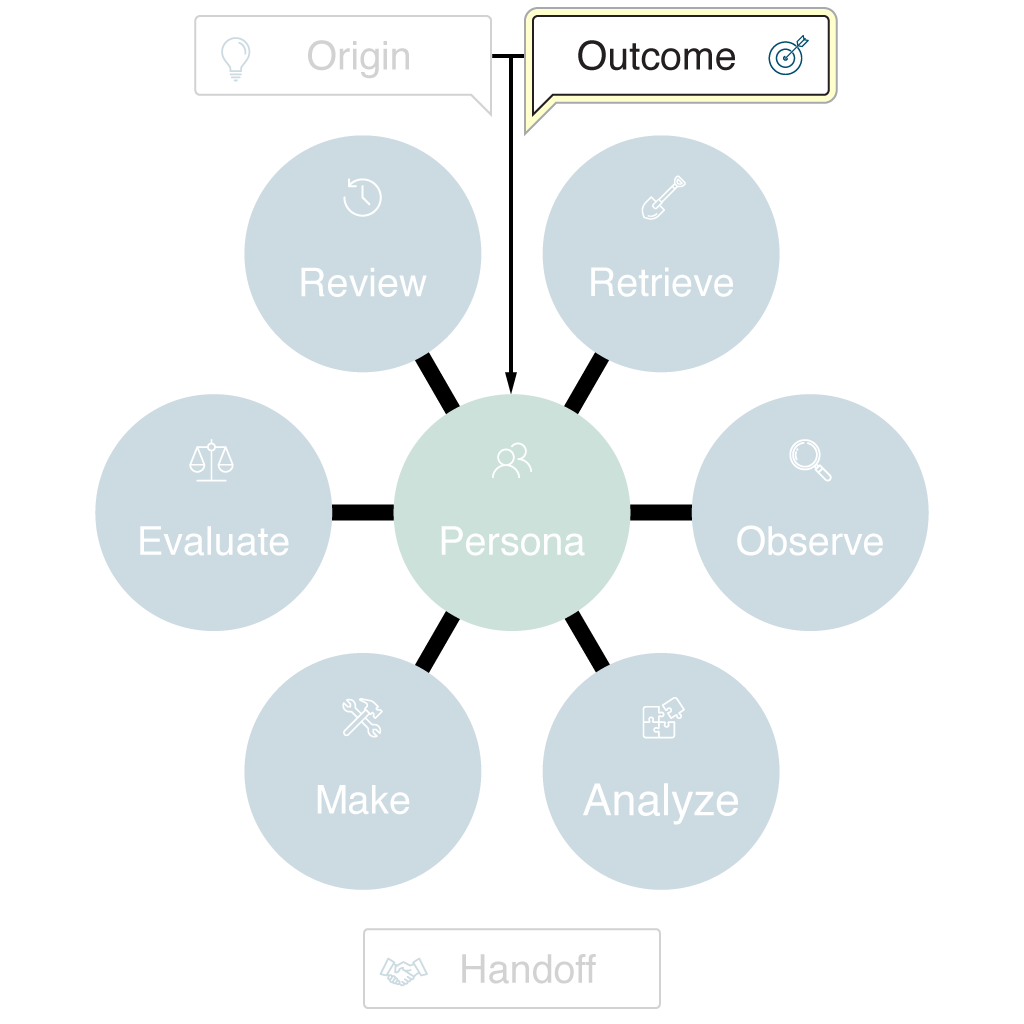
The Outcome phase defines what success looks like and how it will be measured. This phase is critical for building shared understanding and alignment—not just within your immediate team, but across all stakeholder groups. By collaboratively defining objectives, criteria, and assumptions, you create the conditions for mutual accountability and reduce ambiguity and rework later.
Purpose
- Set clear goals and success criteria that are visible and meaningful to
all key groups - Align all stakeholders—across teams and functions—on the
desired outcomes - Define how progress and success will be measured (KPIs, OKRs, metrics), so that every contributor and beneficiary knows what matters
- Surface and address competing objectives, assumptions, or risks to avoid downstream conflict
Key Questions
- What does success look like for this work? (Include perspectives from all relevant groups)
- What are the specific objectives and intended results? Are these clearly shared across stakeholder boundaries?
- How will we measure progress and determine if we’ve succeeded? Who will track, and who will validate?
- What are the KPIs, OKRs, or metrics that matter most? Are they visible to all key contributors and stakeholders?
- Are there competing or conflicting objectives among stakeholders? How will we negotiate alignment?
- What assumptions are we making about outcomes? Are they explicit and agreed?
- How will we handle changes to objectives during the project, and how will these be communicated?
- What are the risks if outcomes are not met, and who is impacted?
Read the research report on defining the outcome of work. [Document Link – PDF]
Case Study Example: Dog Park Finder App (Fetch Spotter)
Applying the Outcome Phase:
What does success look like for this work?
- Dog owners can easily find, rate, and review nearby dog parks through the app.
- A successful launch means high app adoption in key cities, positive user feedback, and active contributions of park information and reviews.
What are the specific objectives and intended results?
- 5,000 downloads within 3 months of launch
- 500 user-generated park reviews in the first 90 days
- At least 80% of users report satisfaction with park discovery
- App is featured in local pet owner newsletters
How will we measure progress and determine if we’ve succeeded?
- App analytics (downloads, retention, engagement)
- User surveys and in-app feedback
- Tracking number and quality of reviews and park submissions
What are the KPIs, OKRs, or metrics that matter most?
- KPI: App downloads per week
- KPI: Number of reviews submitted
- KPI: User retention at 30 and 90 days
- KPI: User satisfaction score (survey-based)
Are there competing or conflicting objectives among stakeholders?
- Product wants rapid growth
- Marketing wants high visibility
- Engineering wants platform stability
- City partners want accurate, up-to-date information (potential tradeoffs between speed and data verification).
What assumptions are we making about outcomes?
- Dog owners will submit honest, useful reviews
- City partners will collaborate to provide park data
- Viral features will drive app adoption
How will we handle changes to objectives during the project?
- Monthly objective reviews with key stakeholders
- Pivots documented and communicated via project tracker
What are the risks if outcomes are not met?
- Wasted dev/marketing budget
- Lowered brand reputation
- Delayed or canceled future community features
- Early risks from Origin phase (e.g., data access) will be monitored throughout and revisited at project checkpoints
| Strategic Outcome | Objective / Initiative | Success Metric (KPI/OKR) | Accountable Group(s) |
|---|---|---|---|
| High User Adoption | Launch Dog Park Finder App in 3 cities | 5,000 downloads in 3 months | Product, Marketing |
| Active Community Engagement | Drive user-generated park reviews | 500 reviews in 90 days | Product, Customer Success |
| User Satisfaction | Ensure effective park discovery | 80%+ users report satisfaction | Product, Customer Success |
| Visibility & Growth | Gain earned media/newsletter features | App featured in 2+ newsletters | Marketing |
| Data Accuracy & Collaboration | Build partnerships for up-to-date data | City partner data feeds est. | Product, City Partners, Eng. |
| Retention | Retain active users after download | 30- and 90-day retention rates | Product, Engineering, Cust. Success |
Sample Outcomes Map — Dog Park Finder App
This outcomes map links strategic goals to actionable metrics and clarifies who is accountable for each result, supporting alignment and transparency across the entire stakeholder ecosystem.
<< Origin Phase

